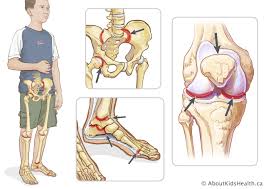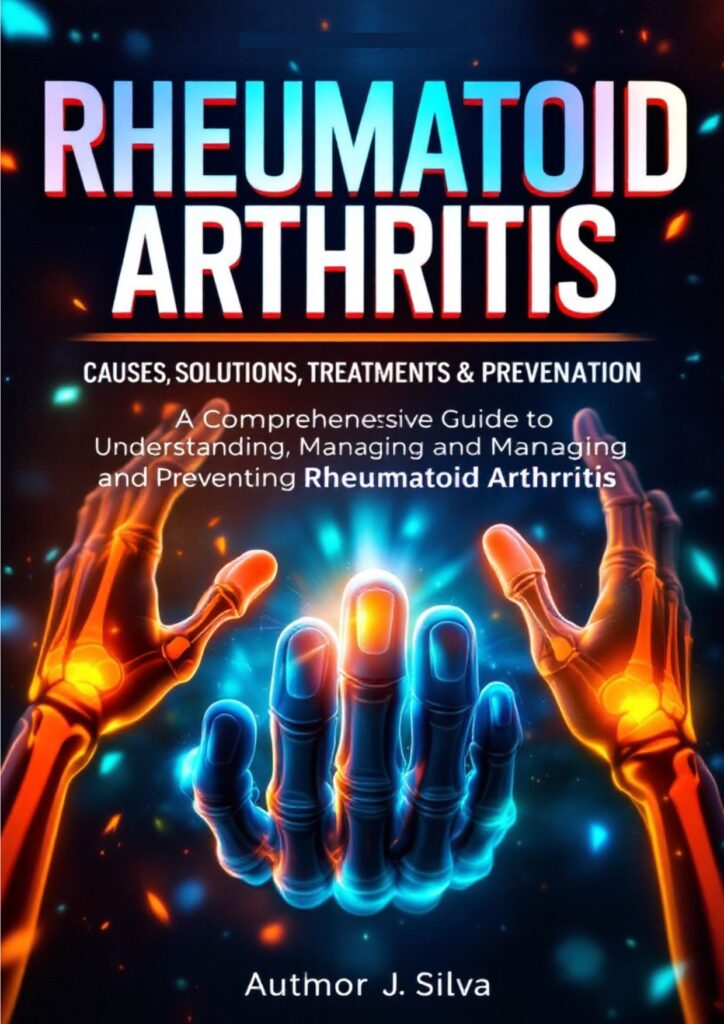
Understanding Juvenile Rheumatoid Arthritis
Juvenile Rheumatoid Arthritis (JRA), also known as Pediatric Rheumatoid Arthritis or Juvenile Idiopathic Arthritis (JIA), is a chronic autoimmune disorder that affects children under the age of 16. The disease causes the immune system to mistakenly attack the body’s own tissues, particularly the joints, leading to inflammation, pain, swelling, and stiffness.

While rheumatoid arthritis in adults is well-known, juvenile rheumatoid arthritis is unique because it occurs during critical stages of growth and development. This makes early detection and proper management essential to prevent long-term damage and disability.
In this article, we will explore in depth the causes, symptoms, treatments, and means of prevention of JRA. We’ll also provide insight into lifestyle strategies that can help children live healthier, more active lives despite their diagnosis.
What Is Juvenile Rheumatoid Arthritis?
Juvenile Rheumatoid Arthritis (JRA) is an autoimmune condition that leads to chronic joint inflammation in children. It’s sometimes called juvenile idiopathic arthritis, but both terms describe similar disease patterns — inflammation of one or more joints lasting at least six weeks with no other identifiable cause.

When untreated, this inflammation can cause damage to cartilage and bone, interfere with normal growth, and affect internal organs. The condition may vary in severity from mild, short-term joint pain to severe, long-lasting inflammation.
Types of Juvenile Rheumatoid Arthritis
Doctors classify JRA into several subtypes based on symptoms and affected areas:
- Oligoarticular JRA: Affects four or fewer joints, typically knees or ankles.
- Polyarticular JRA: Involves five or more joints, resembling adult rheumatoid arthritis.
- Systemic Juvenile Rheumatoid Arthritis (Still’s Disease): Affects the whole body, causing fever, rash, and inflammation in organs.
- Enthesitis-related JRA: Involves inflammation where tendons attach to bones.
- Psoriatic JRA: Occurs in children with psoriasis or a family history of psoriasis.
Each form has unique features but shares the same underlying autoimmune mechanism.
Causes and Risk Factors of Juvenile Rheumatoid Arthritis
Although the exact cause remains unknown, juvenile rheumatoid arthritis is considered an autoimmune disease, meaning the immune system mistakenly attacks healthy joint tissues.
Possible Causes and Triggers
- Genetic predisposition: Certain genes, such as HLA variants, increase the risk.
- Immune system dysfunction: The immune system becomes overactive, attacking the body’s own tissues.
- Environmental triggers: Viral or bacterial infections might activate the immune response.
- Hormonal influences: Puberty and hormonal changes may contribute to disease onset.
Children with a family history of autoimmune diseases, such as lupus or rheumatoid arthritis, are at higher risk.
Key Risk Factors
- Family history of autoimmune conditions
- Female gender (JRA affects girls more than boys)
- Early childhood infections
- Environmental exposure to toxins or pollutants
Early recognition of these risk factors can help in preventive monitoring and quicker intervention.
Juvenile Rheumatoid Arthritis Symptoms
Recognizing the juvenile rheumatoid arthritis symptoms early is critical to prevent irreversible joint damage.
Common JRA Symptoms
- Persistent joint pain, swelling, or stiffness
- Morning stiffness that improves during the day
- Fatigue or irritability
- Limping or difficulty using limbs
- Reduced range of motion
- Unexplained fever or rash (especially in systemic JRA)
- Swollen lymph nodes
Systemic Juvenile Rheumatoid Arthritis Symptoms
Systemic JRA, the most severe form, may cause:
- High spiking fevers
- Salmon-colored rash
- Inflammation of internal organs such as the heart or liver
- Anemia and growth delays
Children may also develop uveitis, an eye inflammation that can lead to vision loss if untreated.
Juvenile Rheumatoid Arthritis Diagnosis
Diagnosing childhood rheumatoid arthritis involves a combination of physical exams, lab tests, and imaging.
Diagnostic Steps
- Medical history and physical examination: Checking joint swelling, tenderness, and movement.
- Blood tests:
- Rheumatoid factor (RF)
- Antinuclear antibody (ANA)
- Erythrocyte sedimentation rate (ESR)
- C-reactive protein (CRP)
- Imaging: X-rays, ultrasound, or MRI to detect joint damage.
- Eye exams: Regular ophthalmologic screening for uveitis.
Early diagnosis allows for early treatment, reducing complications.
Juvenile Rheumatoid Arthritis Treatment Options
There is currently no cure for juvenile rheumatoid arthritis, but various treatments can control symptoms and prevent long-term damage.
Medical Treatments
- Nonsteroidal Anti-inflammatory Drugs (NSAIDs):
- Ibuprofen or naproxen to reduce pain and inflammation.
- Disease-Modifying Antirheumatic Drugs (DMARDs):
- Methotrexate is the most common. It slows disease progression.
- Biologic Response Modifiers:
- Medications such as etanercept, adalimumab, or infliximab target specific immune pathways.
- Corticosteroids:
- Used for severe inflammation, but long-term use has side effects.
Non-Pharmacological Treatments
- Physical therapy: Maintains joint flexibility and strength.
- Occupational therapy: Helps children adapt daily activities.
- Regular exercise: Swimming and cycling are gentle on joints.
- Healthy diet: Anti-inflammatory foods like salmon, leafy greens, and berries can help.
Psychological Support
Children with JRA often face emotional challenges. Support groups and therapy can help them cope with pain and social limitations.
Means of Prevention for Juvenile Rheumatoid Arthritis
While it’s impossible to prevent JRA entirely, certain strategies may reduce risks and manage early symptoms effectively.
1. Strengthening the Immune System
- Maintain a balanced diet rich in vitamins C, D, and omega-3 fatty acids.
- Encourage daily physical activity to improve immune resilience.
- Ensure adequate sleep and stress management.
2. Early Detection and Monitoring
Regular pediatric checkups are key. Early signs such as morning stiffness or unexplained fever should not be ignored.
3. Managing Infections Promptly
Since infections can trigger immune responses, ensure that children receive timely medical attention for viral or bacterial illnesses.
4. Avoiding Environmental Toxins
Limit exposure to cigarette smoke, pollutants, and pesticides — all of which can trigger immune dysregulation.
5. Promoting Healthy Weight
Obesity increases joint stress and inflammation. Encourage active play and a healthy diet to maintain a proper weight.
6. Vitamin D and Sunlight Exposure
Moderate sun exposure and vitamin D supplements may support immune function and bone health, reducing inflammation risk.
Get Your Ultimate Guide to Rheumatoid Arthritis Now!
Are you struggling with rheumatoid arthritis or worried about the early signs of RA? Don’t wait until the pain gets worse! Our comprehensive eBook, Rheumatoid Arthritis: Causes, Solutions, Treatments & Prevention, is your complete guide to understanding RA, managing symptoms, and preventing joint damage.
Click here to get your eBook now!
Why you need this eBook:
- Easy-to-understand language, perfect for anyone dealing with RA
- Actionable solutions and preventive measures you can implement today
- Professional, science-backed guidance from experts in autoimmune health
Self-Care Tips for Managing Rheumatoid Arthritis
Managing rheumatoid arthritis requires daily awareness and lifestyle adjustments. Here are simple, proven strategies:
Living With Juvenile Rheumatoid Arthritis
Children with juvenile RA can lead active lives with proper management.
School and Social Support
Teachers should be aware of the condition to make necessary accommodations — such as extra time for writing or modified physical activities.
Nutrition and Lifestyle
- Anti-inflammatory diet: Focus on whole foods, lean proteins, and omega-3s.
- Hydration: Drink plenty of water to maintain joint health.
- Routine exercise: Gentle stretching and yoga can improve mobility.
Family and Emotional Support
Encourage open communication and connect with other families managing JRA through organizations like the Arthritis Foundation.
Complications of Untreated Juvenile Rheumatoid Arthritis
If not properly treated, pediatric rheumatoid arthritis may lead to:
- Joint deformities and chronic pain
- Growth disturbances
- Osteoporosis
- Eye damage (uveitis)
- Organ inflammation
Timely intervention can significantly reduce these risks.
Latest Research and Future Directions
Ongoing research aims to better understand the autoimmune mechanisms behind JRA and develop targeted biologic therapies.
Recent studies published on NCBI suggest that early biologic treatment may induce long-term remission in some patients.
Emerging gene therapy and immunomodulation techniques may one day make JRA preventable or curable.
FAQ – Juvenile Rheumatoid Arthritis
1. What are the early signs of juvenile rheumatoid arthritis?
Common early signs include joint swelling, stiffness in the morning, fatigue, and occasional fever.
2. Can juvenile rheumatoid arthritis be cured?
There is no cure yet, but early treatment can lead to remission and long-term control of symptoms.
3. How is juvenile rheumatoid arthritis different from adult RA?
JRA affects children under 16, often involves growth-related complications, and may resolve with age, unlike adult RA.
4. Is exercise safe for children with JRA?
Yes, low-impact activities like swimming and cycling improve mobility and reduce stiffness.
5. What role does diet play in JRA prevention?
A balanced diet rich in omega-3s, antioxidants, and vitamins supports the immune system and reduces inflammation.
Conclusion: Taking Steps Toward Prevention
Juvenile Rheumatoid Arthritis is a challenging condition that affects both children and their families. While there is no definitive way to prevent JRA, adopting a healthy lifestyle, managing infections, and recognizing symptoms early can significantly reduce complications.
Ongoing research and improved therapies offer hope for children diagnosed with juvenile RA, enabling them to live fulfilling, active lives. Awareness, timely diagnosis, and consistent medical care are the most powerful means of prevention and management.
References:
SEE ALSO: Juvenile Rheumatoid Arthritis: A Comprehensive Review
SEE MORE:Rheumatoid Arthritis Symptoms
Disclaimer: This article is for informational purposes only and does not replace the advice of a healthcare professional. Consult a doctor or nutritionist before starting any supplementation. Some links in the text are affiliate links, which means we may receive a commission if you make a purchase. This does not impact the price for you and helps us continue to bring you quality content.
